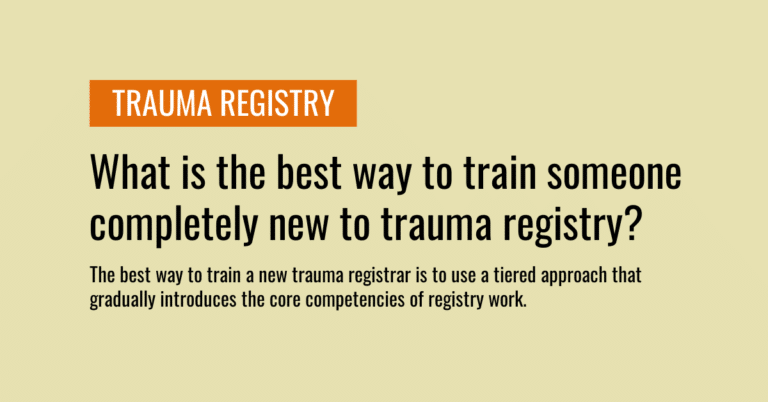The best way to train a new trauma registrar is to use a tiered approach that gradually introduces the core competencies of registry work.
1. Introduce basic concepts

Initial training should focus on acquainting the registrar with basic tools and concepts. Provide teaching content on the various injury and procedure coding systems and show the new registrar how to use the various coding resources. Create practice scenario worksheets that allow the registrar to exercise and test their new knowledge.
In addition, have the new registrar read through the entire National Trauma Data Standard (NTDS) Data Dictionary and your hospital data dictionary. Even though the new team member will absorb only a fraction of the content, this is a crucial step to gaining a working knowledge of the trauma data landscape.
2. Provide hands-on experience
Once the new registrar understands some basic concepts, allow him or her to explore your hospital’s various trauma data sources and your program’s registry software in a test environment. Assign the new registrar a patient chart and have them go through it with the NTDS Data Dictionary.
In general, registrar training requires a hands-on approach. Have the registrar abstract one group of fields at a time and provide real-time feedback at every step. Create a working relationship in which the new team member feels comfortable asking any question. Ultimately, giving trainees the opportunity to get comfortable with each set of fields before moving to the next will improve their accuracy.
3. Monitor quality
You can use your center’s interrater reliability (IRR) process to support registrar onboarding. When examining charts abstracted by newer registrars, choose a few fields from every screen for validation (in addition to your center’s standard IRR fields). This will help ensure the new registrar is mastering the full range of data definitions and codes.
4. Hasten slowly
On one hand, the new registrar should be allowed to get comfortable with one set of concepts before moving on to the next. On the other hand, people learn by doing, so gently pushing registrars forward will help them grow.
Still, it is important to avoid rushing a trainee into advanced education too quickly. For example, it does not make sense to send a registrar who has been on the job one month to an ICD-10 course.
5. Document the process
As always, aim for consistency. Create a standard process for training new registrars and document it. That way, your registrar training process will be measurable and reproducible.
This article was originally published in February 2024 in the Trauma Registry & Data Management Special Report. It is based on remarks and guidance provided by trauma data experts Melissa Sorensen and Amanda Truelove during the December 2023 “Trauma Registry Consult” webinar.

